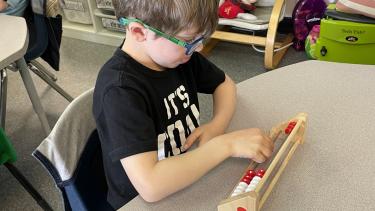
Building Future Mathematicians
The way that students experience math is fundamental to how they view themselves as mathematicians. We want students to experience math in a way that encourages a willingness to engage in productive struggle, see that mistakes truly do result in learning, and become confident thinkers. Using concrete manipulatives is an integral part of building strong mathematical thinking because they deepen students’ conceptual understanding. For example, letting students touch, explore, and ask questions about how Base 10 blocks can be used to show what is happening when we solve 65 x 23 before being introduced to the algorithm, helps build meaning for when the algorithm is introduced. Or when solving 8 + 6, rekenreks can be used to help decompose numbers and build computational fluency.
For the past two years, a series of workshops focused on manipulatives have been available to teachers in Grades K – 8. Teachers have learned how to use manipulatives meaningfully with students and received classroom manipulative kits to put into action what they’ve learned. Workshops have focused on ten frames, Base 10 blocks, rekenreks, and Cuisenaire rods. Participants have reflected that at the start of teaching a new concept, they see the value in taking time for all students to learn through manipulatives because it deepens conceptual understanding and makes the move to symbolic representation easier and quicker. Teachers find that when using manipulatives students are more engaged, can talk more easily about their thinking, and approach math more positively.
Manipulatives are for all learners, not just young students and not just students who may be struggling to understand. Manipulatives provide something tangible students can touch, move, and change as they build meaning, take risks, and make connections between concepts. Students will not always need to physically touch the manipulatives; they’ll eventually start drawing the manipulatives to help them think and then move to representing their thinking symbolically through numbers by just visualizing the manipulatives (this is called concreteness fading). Workshops focused on manipulatives will be available again next year, but in the meantime to learn more, visit the Curriculum Resources webpage, and check out the Math section where you’ll find suggestions for using manipulatives